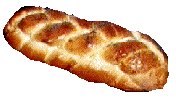 It is an age-old custom,
handed down from pre-Christian times, to eat the meat of
this animal on festive occasions. Thus the English and
Scandinavians ate boar meat and the Germans and Slavs
roast pork on Christmas Day. Also, in many parts of
Europe roast pork is still the traditional main dish at
weddings and on major feast days. At Easter, smoked or
cooked ham, as well as lamb, has been eaten by most
European nations from ancient times, and is the
traditional Easter dish from coast to coast in this
country. Roast pork is another traditional main dish in
some countries. It is an age-old custom,
handed down from pre-Christian times, to eat the meat of
this animal on festive occasions. Thus the English and
Scandinavians ate boar meat and the Germans and Slavs
roast pork on Christmas Day. Also, in many parts of
Europe roast pork is still the traditional main dish at
weddings and on major feast days. At Easter, smoked or
cooked ham, as well as lamb, has been eaten by most
European nations from ancient times, and is the
traditional Easter dish from coast to coast in this
country. Roast pork is another traditional main dish in
some countries.
The nations of central and eastern Europe have other traditional Easter foods, prepared on the last days of Holy Week, blessed by the priest on Holy Saturday or Easter Sunday, and solemnly displayed on a festive table for Easter Week meals. This blessed Easter fare is called Weihessen (blessed food) in Germany and Austria, Swiecone or Swieconka (sanctified) among the Ukrainians and Poles. The figure of the Easter lamb, which rests on a bedding of evergreen twigs, is surrounded by colored Easter eggs. Around this centerpiece are arranged other foods in great variety and large amounts: Easter breads, meats, sausages, salads, cheese, pastry, spices, and fruit. The whole table and every dish on it are decorated with garlands and clusters of leaves, herbs, and flowers. It would be impossible to include in one small book the traditional Easter fare of every nationality. Here are a few of the better-known dishes: |
|
 The Russian Easter
bread (paska) is made of flour, cottage cheese, sugar,
raisins, eggs, and milk. It is put in a mold and shaped
in firm, square pieces, about eight inches high, with a
cross on each side, and the letters J. C. (Jesus Christ)
imprinted in relief. In Germany and Austria the Easter
bread is made with milk, eggs, and raisins, and baked in
oblong loaves of twisted or braided strands
(Osterstollen). Another kind of Austrian Easter bread is
the Osterlaib (Easter loaf), a large, flat round loaf
marked with the cross or an image of the lamb. In some
parts of Ireland people eat on Easter Sunday "Golden
bread" which is very similar to our French toast. The Russian Easter
bread (paska) is made of flour, cottage cheese, sugar,
raisins, eggs, and milk. It is put in a mold and shaped
in firm, square pieces, about eight inches high, with a
cross on each side, and the letters J. C. (Jesus Christ)
imprinted in relief. In Germany and Austria the Easter
bread is made with milk, eggs, and raisins, and baked in
oblong loaves of twisted or braided strands
(Osterstollen). Another kind of Austrian Easter bread is
the Osterlaib (Easter loaf), a large, flat round loaf
marked with the cross or an image of the lamb. In some
parts of Ireland people eat on Easter Sunday "Golden
bread" which is very similar to our French toast.A favorite Easter pastry in Poland are the mazurki, originating in the province of Mazuria, which are very sweet cakes made with honey and filled with nuts and fruit. The most popular of the coffee cakes in Poland and other countries, too, is called baba, a provincialism for woman. The cake is always baked in a fluted pan. It resembles the skirt of a woman. Babka, a word commonly used for grandmother, is the same cake but in a smaller size. Babecska is the diminution of the word. Small rolls or cupcakes are called babeczki. Here is a good recipe for Easter baba (Baba Wielkanocna): |
|
| 1 cup milk 1 tsp. vanilla 3 cups flour 1/4 tsp. almond flavoring 1 /4 cup lukewarm milk 1 cup chopped almonds 2 yeast cakes |
1 c chopped orange citron 1/2 cup plus 1 tabl. sugar & lemon peel 2 tsp. salt 1/2 cup melted butter 15 egg yolks bread crumbs |
Another delightful Easter delicacy are the Papal
Wafers, |
|
| 2/3 cup butter 1 whole egg 7 egg yolks |
2 cups flour 1/2 cup sugar 1 tsp. baking soda |
An Austrian pastry is the Weihkuchen (blessed cake) made of flour, oil, milk, butter, and honey. The people of Transylvania bake their ham in a cover of bread dough. The Hungarian Easter meat loaf is made of chopped pork, ham, eggs, bread, and spices. About thirty years ago breweries in Norway started to make a special Easter beer (Paskelbrygg), a blend of the best beers made locally. It became very popular, and today Paskelbrygg is a favorite addition to traditional Easter fare in Scandinavia. |
|
|
|
| Previous | Return to Easter Page |
 called Sucharki Papieskie:
called Sucharki Papieskie:
